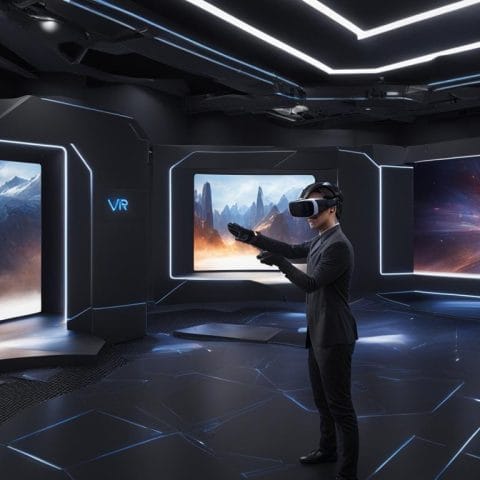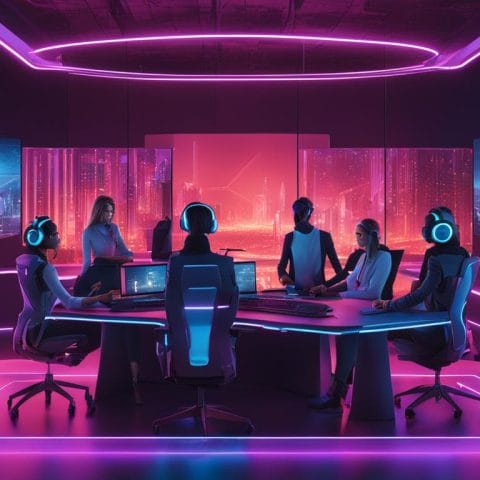Effective leadership is not just about managing a team or achieving short-term goals. It requires a broader perspective, a clear vision that inspires and guides others. Visionary leaders have the ability to see beyond the present and imagine a better future. They possess the strategic insights needed to navigate challenges and drive organizational success.
Warren Bennis, a renowned leadership expert, emphasizes that forming a compelling vision and communicating it effectively is a critical competency for leaders. Simon Sinek, in his book “Start With Why,” further highlights the importance of vision in leadership. A leader’s vision should be powerful, resonating with the values and aspirations of the team. It provides direction, inspiration, and purpose.
Key Takeaways:
- A leader’s vision is a critical leadership competency.
- A compelling vision resonates with the values and aspirations of the team.
- A leader’s vision provides direction and inspiration.
- Visionary leaders have strategic insights to navigate challenges.
- Effective communication of the vision is crucial for inspiring and guiding others.
The Importance of a Clear Vision
A vision is not just a goal but a guide for decision-making, strategy, and innovation. It is a crucial element of effective leadership and strategic vision plays a vital role in inspiring and aligning teams towards a common purpose. A clear vision acts as a compass, providing direction and clarity during uncertain times.
A strong vision is rooted in the values and aspirations of the leader and the organization. It goes beyond mere objectives and encapsulates a strategic perspective that encompasses the broader goals and objectives of the team or company.
A compelling vision serves as a rallying point for the entire team, fostering unity, commitment, and motivation. It provides individuals with a sense of purpose and direction, empowering them to make decisions aligned with the overarching vision.
A clear and compelling vision acts as a unifying force, bringing together individuals with diverse talents, perspectives, and skills to work towards a shared goal.
However, articulating a vision that resonates with the team requires effective communication. A visionary leader must be able to clearly articulate their vision, ensuring that it connects with the emotions and aspirations of their team members.
“Without vision, even the most talented individuals flounder. But with vision, they can achieve extraordinary things.” – Doug Conant
By building a shared understanding of the strategic vision, leaders can empower their teams to make decisions and take actions that align with the desired outcomes. A clear vision, communicated effectively, serves as a source of inspiration, motivation, and guidance for the entire organization.
Effective Leadership and Strategic Vision
Leadership qualities such as effective communication, strategic thinking, and the ability to inspire and motivate others are all intimately tied to the formulation and realization of a clear vision.
Effective leaders not only possess a strategic vision but also have the ability to translate that vision into actionable strategies and plans. They have the foresight to anticipate challenges and adapt their vision to changing circumstances.
Furthermore, effective leaders embody their vision, leading by example and demonstrating the behaviors and values that are aligned with the strategic vision. Their actions inspire trust and belief in the vision, encouraging their team members to actively contribute to its realization.
Effective leadership requires not only the ability to create a compelling vision but also to inspire others to actively engage in bringing that vision to life.
Strategic vision is a key element in effective leadership, as it provides a framework and direction for achieving organizational goals and driving long-term success.
Forming a Compelling Vision
When it comes to forming a compelling vision, leaders can draw inspiration from Simon Sinek’s concept of the “Golden Circle.” This framework emphasizes the importance of starting with the “Why” rather than the “What” or the “How.” By identifying and articulating the underlying purpose and belief that drives their leadership, they can create a vision that truly resonates with others.
A compelling vision goes beyond just words and goals – it has the power to inspire action and draw people in. It ignites passion and motivation within individuals and encourages them to be part of something greater than themselves. A visionary leader understands the importance of connecting with people on an emotional level, tapping into their desires, and aligning those desires with the vision.
“People don’t buy what you do; they buy why you do it.”
– Simon Sinek
Moreover, a compelling vision is not fixed or static. It should be adaptable and resilient, constantly evolving to navigate the ever-changing world. Transformational leaders embrace change and uncertainty, using them as opportunities to refine and enhance their vision. They are open to new ideas and perspectives, willing to adjust their course to stay aligned with their ultimate goal.
Collaboration plays a crucial role in bringing a vision to life. The book “Together is Better” beautifully illustrates the value of working together, highlighting the power of shared purpose, camaraderie, and collective effort. By fostering collaboration and involving others in the vision-building process, leaders can tap into diverse perspectives and ideas, enriching the final vision and creating a sense of ownership among team members.
Realizing the importance of forming a compelling vision sets the foundation for visionary leadership. By starting with the “Why,” inspiring action, adapting to change, and embracing collaboration, leaders can create a vision that propels their teams toward a shared future.
Crafting a Vision for the Future
A leader’s vision serves as a powerful force that propels the team forward, inspiring collaboration, innovation, and mutual investment in the journey. By crafting a compelling vision with an authentic ‘Why’ at its core, visionary leaders can ignite the flames of inspiration within their teams.
Simon Sinek’s book, “The Infinite Game,” takes the concept of vision to a broader context, emphasizing the importance of adopting a long-term mindset for sustainable progress. In this infinite game of leadership, visionary leaders focus not only on achieving immediate goals but also on creating a lasting impact, guiding their teams towards a future brimming with possibilities.
When team members are united by a shared vision, they are driven to go above and beyond, transcending individual limitations to create remarkable outcomes. A captivating vision fuels their passion, ignites their creativity, and motivates them to persevere through challenges.
“The only way to build a better future is by focusing on becoming a better version of yourself today.” – Simon Sinek
Visionary leaders possess the ability to unite diverse talents, harnessing the collective genius within the team. By nurturing an environment of trust and empowerment, they inspire team members to bring their unique perspectives and skills to the table.
This table showcases the transformational power of visionary leadership, highlighting how it can inspire and propel teams towards a brighter future:
| Benefits of Visionary Leadership | Examples |
|---|---|
| Bolsters team collaboration and innovation | Elon Musk’s vision for SpaceX, pushing the boundaries of space exploration |
| Fosters a sense of purpose and engagement | Patagonia’s vision for sustainable and ethical outdoor apparel |
| Drives organizational growth and success | Jeff Bezos’ relentless pursuit of customer-centricity at Amazon |
| Creates a compelling employee experience | Tony Hsieh’s vision for Zappos, delivering exceptional customer service |
Through visionary leadership, teams are empowered to transcend boundaries, surpass their potential, and shape a future that exceeds expectations.
The Journey Towards Visionary Leadership
- Develop a deep understanding of your personal values and purpose.
- Embrace continuous learning to expand your knowledge and perspective.
- Seek feedback from team members and stakeholders to refine your vision.
- Communicate your vision effectively, inspiring and engaging your team.
By embarking on this journey of self-discovery and growth, you can unlock the transformative power of visionary leadership, paving the way for a future where your team thrives and your vision becomes a reality.
Strategic Insights for Leaders

Strategic leadership is a fundamental aspect of effective leadership. It requires the ability to create a vivid and achievable vision, which serves as a compass for the organization. However, strategic leadership goes beyond just envisioning the future. It involves strategic thinking and planning to turn that vision into a roadmap for success.
One key element of strategic leadership is embracing innovative thinking and fostering a culture of creativity. By encouraging experimentation and welcoming new ideas, leaders can stimulate innovation within their teams. This allows for the development of unique strategies and solutions that drive growth and competitive advantage.
Effective communication of the vision is also crucial for strategic leadership. Leaders must articulate their vision clearly and passionately, ensuring that every team member understands and connects with it. This helps rally the team around a common goal and fosters a sense of purpose and unity.
However, strategic leadership is not without its challenges. Leaders must strike a balance between focusing on the long-term vision and addressing day-to-day challenges. It requires prioritizing and making strategic decisions that align with the overall strategic plan.
Below is a table outlining the key aspects of strategic leadership:
| Aspects of Strategic Leadership | Description |
|---|---|
| Strategic Thinking | Ability to analyze complex situations, identify trends, and develop forward-thinking strategies. |
| Strategic Planning | Process of setting goals, defining strategies, and creating action plans to achieve the vision and objectives. |
| Innovative Thinking | Encouraging creativity, embracing new ideas, and driving innovation within the organization. |
| Effective Communication | Articulating the vision clearly and passionately, and ensuring that it resonates with the team. |
| Balance | Striking a balance between long-term vision and day-to-day operations, making strategic decisions that align with the overall plan. |
By embodying strategic leadership, leaders can guide their organizations towards a successful future. It requires a combination of visionary thinking, strategic planning, innovative mindset, effective communication, and the ability to navigate challenges with a long-term perspective.
Becoming a Strategic Leader
Strategic thinking and vision are essential skills for leaders to navigate the complexities of the modern business world. A clear vision acts as a guiding star, while strategic planning turns that vision into a roadmap. Innovative thinking and effective communication are key to realizing the vision. Leaders must also balance immediate needs with long-term objectives.
Strategic acumen is the ability to assess and analyze complex situations, identify opportunities, and make informed decisions that align with the overall vision. It involves a deep understanding of market dynamics, industry trends, and organizational capabilities. Leaders with strategic acumen are able to anticipate challenges, adapt to changes, and seize the right opportunities at the right time.
“The most successful leaders are those who can anticipate the future and position their organizations for success.”
To cultivate strategic acumen, leaders must actively seek knowledge and stay updated on industry trends and emerging technologies. They should engage in continuous learning and professional development to enhance their strategic thinking skills. Building a network of diverse perspectives can also contribute to a broader understanding of the business landscape.
Effective leaders understand the importance of collaboration and involving their teams in the strategic planning process. By harnessing the collective intelligence and diverse perspectives of their team members, leaders can make more informed decisions and create a sense of ownership and buy-in towards the vision.
Developing Strategic Acumen
Here are some strategies to develop strategic acumen:
- Stay informed: Read industry reports, attend conferences and workshops, and subscribe to relevant publications to stay updated on market trends and emerging technologies.
- Seek diverse perspectives: Surround yourself with a diverse group of individuals, both within and outside your organization, who can provide different viewpoints and challenge your thinking.
- Practice critical thinking: Analyze complex problems, assess risks and opportunities, and evaluate alternative courses of action to develop your analytical and decision-making abilities.
- Embrace innovation: Encourage a culture of innovation within your organization, where ideas are welcomed, and continuous improvement is valued. Foster an environment that supports experimentation and learning from failures.
Strategic leadership requires a combination of visionary thinking, strategic planning, and the ability to execute and adapt. Leaders who possess strategic acumen can effectively navigate the ever-changing business climate and steer their organizations towards success.
The Roadmap to Success
Achieving strategic success requires a roadmap that outlines the steps to be taken and the milestones to be achieved. This roadmap serves as a guide, providing a clear direction and ensuring alignment with the overall vision.
| Steps | Description |
|---|---|
| 1 | Define the vision: Clearly articulate the organization’s vision, including its purpose, values, and long-term goals. |
| 2 | Assess the current state: Conduct a thorough analysis of the organization’s internal and external environment, including strengths, weaknesses, opportunities, and threats. |
| 3 | Set strategic objectives: Based on the analysis, establish strategic objectives that align with the vision and address the challenges and opportunities identified. |
| 4 | Create an action plan: Develop a detailed action plan that outlines the key initiatives, resources required, and timelines for achieving the strategic objectives. |
| 5 | Monitor and adjust: Regularly monitor progress towards the strategic objectives and make necessary adjustments to ensure alignment with the changing business landscape. |
By following this roadmap, leaders can effectively translate their vision into action, mobilize their teams, and drive success. Strategic acumen plays a crucial role in each step of the roadmap, guiding decision-making and ensuring that actions are aligned with the overall vision.
In conclusion, becoming a strategic leader requires developing both strategic acumen and a clear vision. Leaders who possess strategic acumen can navigate the complexities of the business world, make informed decisions, and drive their organizations towards success. By following a roadmap to success, leaders can effectively translate their vision into action and achieve their strategic objectives.
The Role of Vision in Leadership Success

Possessing strategic leadership skills and vision allows leaders to actively shape the future of their organizations. Strategic leadership involves actively creating and fostering innovation, growth, and sustained success. It requires a balance between future planning and addressing current challenges.
A visionary leader with strategic leadership skills has the ability to anticipate trends, identify opportunities, and navigate uncertainties. Their strong sense of purpose and clear vision inspire and motivate their teams, driving them towards shared goals.
A strategic leader also possesses the ability to think long-term while strategically planning for the future. They analyze market trends, consumer needs, and technological advancements to stay ahead of the competition.
| Key Skills for Strategic Leadership | Benefits of Future Planning |
|---|---|
|
|
A visionary leader’s strategic leadership skills and future planning empower them to make informed decisions and guide their teams towards success. By embracing innovation and understanding the dynamic landscape, they can develop strategies that drive growth, create competitive advantages, and lead to the achievement of organizational goals. Their strategic vision acts as a roadmap, providing direction and purpose to the entire organization.
Leadership Vision in Action
Leaders who possess a clear vision must also possess the ability to execute that vision effectively. It is not enough to merely articulate the vision; leaders must inspire action, foster unity, and align individual efforts towards the collective goal. This requires continuous communication, adaptation, and nurturing of the vision over time.
Leadership execution is the process of translating vision into tangible outcomes through strategic planning and implementation. It involves making informed decisions, allocating resources effectively, and driving progress towards the desired future state. By executing their vision successfully, leaders can bring about meaningful change and guide their organizations towards success.
One of the key strategies for visionary leadership is to inspire action among team members. Leaders must communicate the vision in a way that ignites passion and motivates individuals to take ownership of their roles in achieving the vision. This can be done through effective storytelling, highlighting the impact and significance of the vision on a personal and organizational level.
“The function of leadership is to produce more leaders, not more followers.” – Ralph Nader
Fostering unity is another essential aspect of leadership vision in action. A strong vision can bring people together, creating a sense of common purpose and shared values. By promoting collaboration and teamwork, leaders can harness the collective intelligence and capabilities of their team members, leading to greater innovation and achievement.
Visionary leadership strategies involve adaptability and flexibility. The ability to pivot and make course corrections is crucial in an ever-changing business landscape. Leaders must continuously evaluate the external environment, gather feedback, and adjust their strategies to ensure the vision remains relevant and attainable.
Strategic leadership is not a one-time event; it is an ongoing practice that requires commitment and dedication. By consistently reinforcing the vision, monitoring progress, and celebrating milestones, leaders can sustain momentum and alignment towards the desired outcomes. Through effective leadership execution and visionary leadership strategies, leaders can turn their vision into a reality.
| Leadership Execution Strategies | Benefits and Impact |
|---|---|
| Clear communication of the vision | Ensures alignment and clarity among team members |
| Effective delegation and empowerment | Fosters trust and enables individuals to contribute their best |
| Regular monitoring of progress | Identifies areas of improvement and enables timely adjustments |
| Celebration of achievements | Motivates and inspires team members to continue striving towards the vision |
Developing Visionary Leadership Skills
Developing visionary leadership skills is essential for enhancing leadership effectiveness and driving organizational success. By honing the ability to form a clear and compelling vision, leaders can inspire and motivate their teams to achieve extraordinary results.
One of the key ways to develop visionary leadership skills is through self-reflection. By understanding their own values, passions, and purpose, leaders can align their vision with their authentic selves. This self-awareness serves as a foundation for inspiring others and creating a shared sense of purpose.
Additionally, seeking feedback and learning from others is crucial in expanding and refining leadership vision. By collaborating with diverse perspectives, leaders can gain insights that help shape and strengthen their vision. Embracing a growth mindset and actively seeking opportunities for learning and development is essential in evolving as a visionary leader.
Continuous growth and adaptation are essential for visionary leadership
A visionary leader must also embrace continuous growth and adaptation. The business landscape is constantly changing, and effective leadership requires staying ahead of these shifts. By staying curious and open-minded, leaders can anticipate trends, innovate, and identify new opportunities.
Visionary leadership is not a static concept but an ongoing journey. It requires leaders to adapt their vision to changing circumstances, refine strategies, and pivot when necessary. By remaining flexible and agile, leaders can navigate challenges and lead their teams towards success.
“Visionary leaders are those who dare to dream, challenge the status quo, and inspire others to create a better future.”
Effective leadership development strategies for visionary leadership
There are several effective leadership development strategies that can help aspiring leaders cultivate their visionary leadership skills:
- Mentorship: Seek guidance and mentorship from experienced visionary leaders who can share their knowledge and insights.
- Networking: Build a strong network of like-minded individuals who can provide support, share ideas, and offer different perspectives.
- Continuing education: Pursue leadership development programs, workshops, and courses to enhance strategic thinking, communication, and visioning skills.
- Embrace failure: Learn from setbacks and use them as opportunities for growth and improvement.
- Practice active listening: Actively listen to the needs and aspirations of team members and stakeholders to ensure the vision is inclusive and resonates with all.
By incorporating these strategies into their leadership journey, aspiring visionary leaders can enhance their effectiveness and make a lasting impact in their organizations.
Developing visionary leadership skills is a continuous process that requires self-reflection, learning from others, and continuous adaptation. By cultivating these skills, leaders can inspire their teams, drive organizational success, and shape a better future.
Vision in the Face of Challenges
Visionary leaders possess the ability to adapt and lead with resilience when faced with challenges. They understand the importance of embracing change and navigating uncertainty, all while keeping their long-term vision in mind. Adapting to change and leading through uncertainty are critical skills that enable leaders to navigate turbulent times and guide their teams towards success.
“The only way to make sense out of change is to plunge into it, move with it, and join the dance.” – Alan Watts
During times of uncertainty, visionary leaders inspire perseverance and provide guidance to their teams. They foster unity and commitment to the vision by promoting open communication, trust, and collaboration. By remaining steadfast in their purpose and keeping the team focused on the bigger picture, they instill confidence and motivation even during difficult times.
Adapting to Change
Adapting to change is an essential skill for visionary leaders. They understand that change is inevitable and that it presents opportunities for growth and innovation. Instead of resisting change, they embrace it and encourage their teams to do the same. They create a culture that values flexibility, continuous learning, and the ability to pivot in response to new challenges and opportunities.
Adapting to change requires a willingness to let go of the familiar and embrace the unknown. It involves seeking alternative perspectives, exploring new strategies, and being open to experimentation. By adapting to change, visionary leaders enable their organizations to stay agile and thrive in dynamic environments.
Leading Through Uncertainty
Leading through uncertainty is another crucial aspect of visionary leadership. Uncertainty can create fear and resistance, making it challenging to maintain focus and momentum towards the vision. However, visionary leaders confidently navigate uncertainty, providing stability and clarity to their teams.
They communicate transparently and honestly about the current challenges and uncertainties, while reassuring their teams that they are capable of overcoming them. They listen to concerns and provide guidance based on a well-defined vision and strategic thinking. By leading through uncertainty, visionary leaders instill confidence, reduce anxiety, and maintain forward progress.
Embracing change and leading through uncertainty require a balance of flexibility and resilience. As the business landscape evolves, visionary leaders must adapt their strategies while staying rooted in their long-term vision. They inspire their teams to embrace change, navigate uncertainty, and persevere in pursuit of the shared vision.
Visionary Leadership for Organizational Transformation
Visionary leadership plays a crucial role in driving organizational transformation. With the ability to articulate a clear and inspiring vision, leaders have the power to align their teams and guide them towards achieving transformative goals. A visionary leader fosters a culture of innovation, adaptability, and growth, which ultimately leads to organizational success.
When an organization undergoes significant change, such as restructuring or entering new markets, visionary leadership becomes even more critical. The leader’s compelling vision serves as a guiding light, providing direction and inspiration to navigate through uncertainty and challenges.
“Vision without action is merely a dream. Action without vision just passes the time. Vision with action can change the world.” – Joel A. Barker
Strong visionary leadership has a profound impact on organizational change. When employees are aligned with a shared vision, they feel a sense of purpose and ownership, enabling them to work towards a common goal. This collaborative approach creates a harmonious work environment, facilitates effective problem-solving, and boosts employee morale and engagement.
Furthermore, visionary leaders embrace innovation and encourage a culture that supports adaptability and growth. They recognize that change is inevitable and actively seek opportunities to challenge the status quo and drive continuous improvement. By fostering a climate that values creativity and forward thinking, these leaders empower their teams to explore new ideas and find innovative solutions to complex problems.
In addition, visionary leaders understand the importance of strategic planning and execution. They develop roadmaps that outline the steps required to realize the vision and ensure that resources are allocated effectively. By setting clear goals and providing the necessary support and guidance, they enable their teams to stay focused, motivated, and on track throughout the transformation journey.
To illustrate the impact of visionary leadership on organizational transformation, consider the following table:
| Key Benefits of Visionary Leadership | Organizational Impact |
|---|---|
| Alignment | Ensures employees are working towards a common goal, leveraging their collective strengths for maximum impact. |
| Innovation | Fosters a culture of creativity and encourages employees to think outside the box, resulting in innovative solutions and improved competitive advantage. |
| Adaptability | Enables organizations to navigate change successfully by embracing new ideas, technologies, and market dynamics. |
| Growth | Drives organizational growth through strategic planning and execution, capitalizing on market opportunities and expanding capabilities. |
| Employee Engagement | Boosts employee morale, satisfaction, and commitment, leading to higher levels of productivity and performance. |
As the table demonstrates, visionary leadership has multifaceted benefits that directly contribute to organizational transformation and success. By championing a clear and compelling vision, leaders inspire their teams to embrace change, think innovatively, and achieve extraordinary results.
Conclusion
Vision in leadership is paramount for organizations to achieve success and drive innovation. A compelling vision serves as a guiding force, influencing decision-making and inspiring action. When leaders effectively communicate their vision, they foster unity among team members and align individual efforts towards a collective goal.
Strategic thinking and planning play a pivotal role in translating a vision into tangible outcomes. By strategically foreseeing future challenges and opportunities, leaders can proactively navigate through obstacles and drive transformative change. Through strategic foresight, leaders can anticipate market trends and industry disruptions, enabling them to make informed decisions that propel their organizations forward.
Leaders who cultivate visionary leadership skills create a thriving organizational culture. They instill a sense of purpose and passion, motivating their teams to perform at their best. By embracing challenges and promoting a growth mindset, visionary leaders empower their workforce, fostering innovation, adaptability, and continuous improvement.
FAQ
What is the importance of a clear vision in leadership?
A clear vision is critical in leadership as it provides direction, inspires action, and fosters unity among team members. It guides decision-making, strategic planning, and innovation.
How can leaders form a compelling vision?
Leaders can form a compelling vision by understanding their values and purpose, articulating the “Why” behind their vision, and aligning it with the values and aspirations of their team.
What is the role of strategic leadership in forming a vision?
Strategic leadership involves creating a vivid and achievable vision, turning it into a roadmap through strategic planning, embracing innovative thinking, fostering creativity, and effectively communicating the vision to rally the team.
How can leaders develop visionary leadership skills?
Leaders can develop visionary leadership skills by engaging in self-reflection, seeking feedback, learning from others, and continuously growing and adapting their leadership approach.
How can visionary leaders navigate challenges and uncertainty?
Visionary leaders navigate challenges and uncertainty by being adaptable and resilient, embracing change, and keeping the long-term vision in mind. They inspire perseverance and guide their teams through difficult times.
How can visionary leadership drive organizational transformation?
Visionary leadership drives organizational transformation by articulating a clear and inspiring vision, aligning teams, fostering a culture of innovation and adaptability, and driving change to achieve transformative goals.
What are some key insights about vision in leadership?
Vision in leadership is crucial for driving organizational success, inspiring teams, and guiding decision-making. By cultivating visionary leadership skills, leaders can navigate challenges, drive change, and foster a thriving organizational culture.





